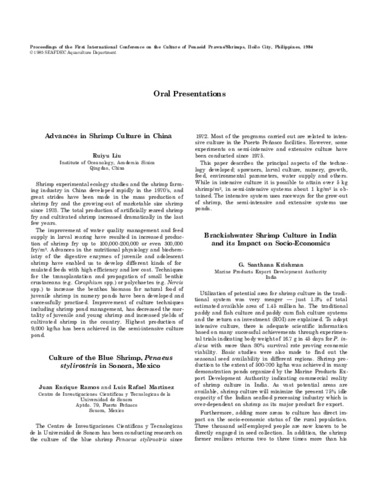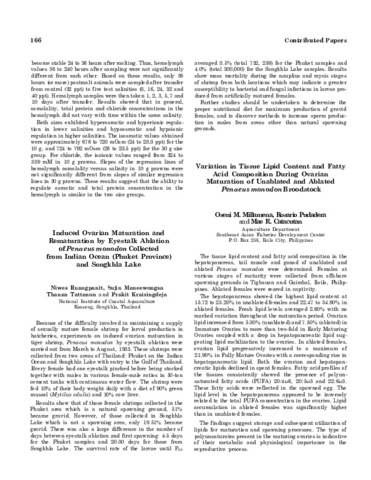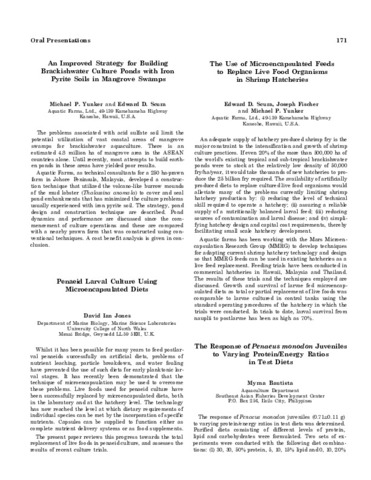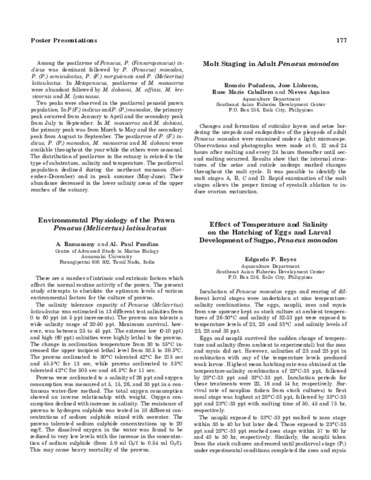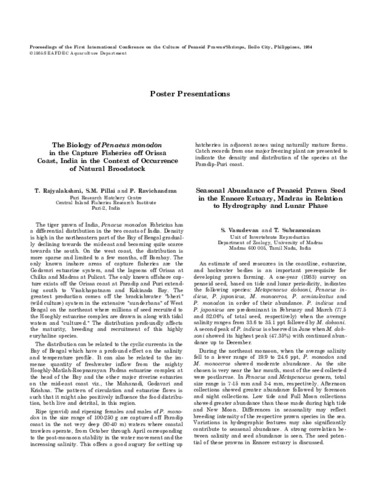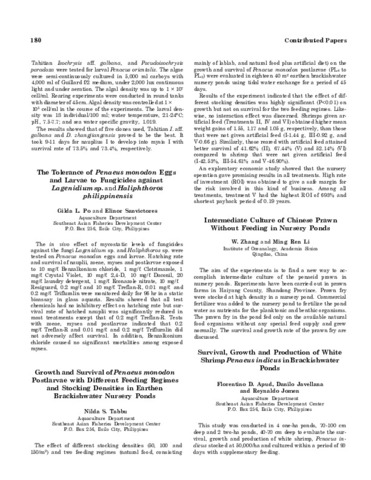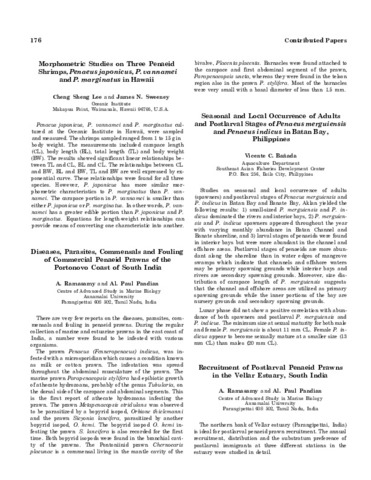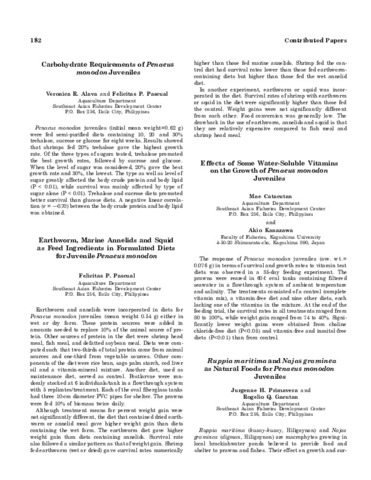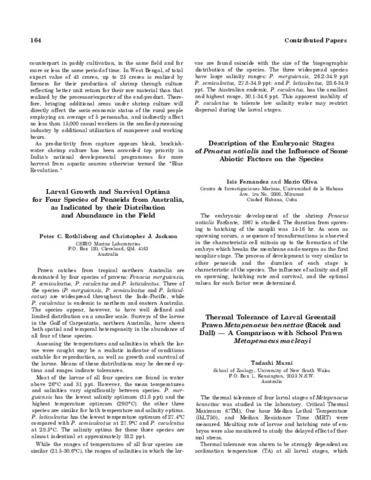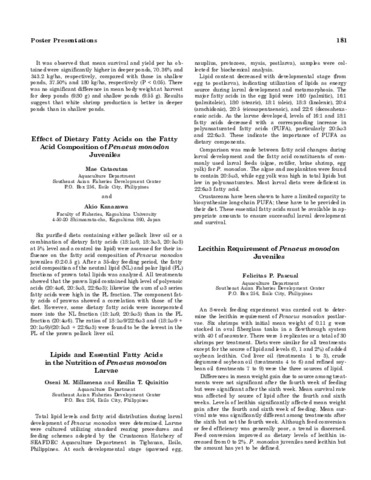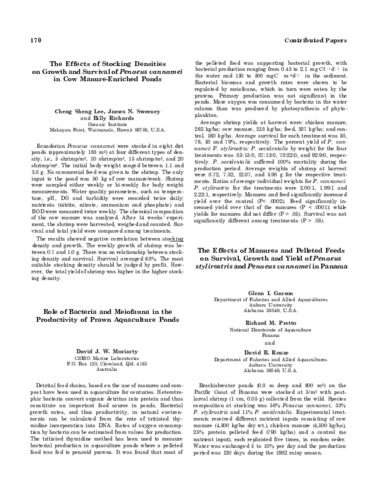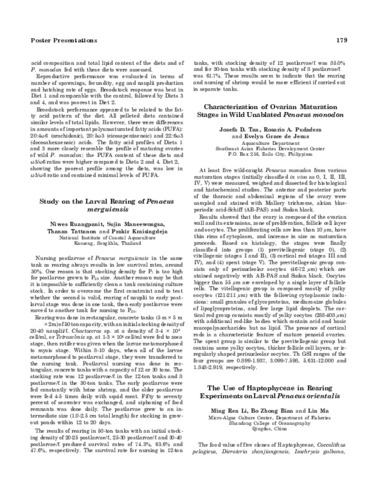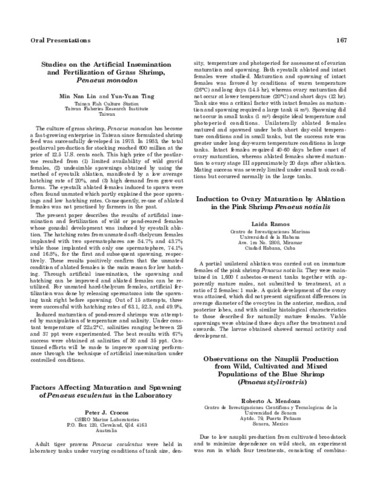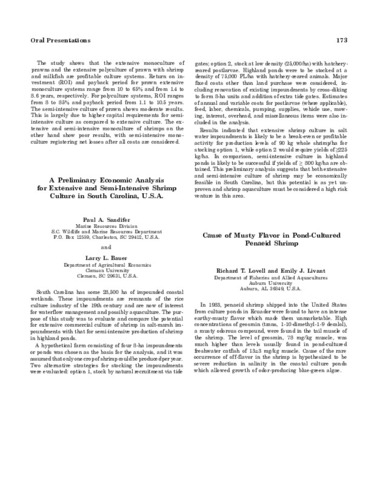Proceedings of the First International Conference on the Culture of Penaeid Prawns/Shrimps: Recent submissions
21-40 / 79
-
Study on the larval rearing of Penaeus merguiensis
(Aquaculture Department, Southeast Asian Fisheries Development Center, 1985)Nursing postlarvae of Penaeus merguiensis in the same tank as rearing always results in low survival rates, around 30%. One reason is that stocking density for P1 is too high for postlarvae grown to P20 size. Another reason ... -
Culture of blue shrimp, Penaeus stylirostris in Sonora, Mexico
(Aquaculture Department, Southeast Asian Fisheries Development Center, 1985)The Centro de Investigaciones Cientificas y Tecnologicas de la Universidad de Sonora has been conducting research on the culture of the blue shrimp Penaeus stylirostris since 1972. Most of the programs carried out are ... -
Induced ovarian maturation and rematuration by eyestalk ablation of Penaeus monodon collected from Indian ocean (Phuket province) and Songkhla lake
(Aquaculture Department, Southeast Asian Fisheries Development Center, 1985)Because of the difficulty involved in maintaining a supply of sexually mature female shrimp for larval production in hatcheries, experiments on induced ovarian maturation in tiger shrimp, Penaeus monodon by eyestalk ablation ... -
The use of microencapsulated feeds to replace live food organisms in shrimp hatcheries
(Aquaculture Department, Southeast Asian Fisheries Development Center, 1985)An adequate supply of hatchery produced shrimp fry is the major constraint to the intensification and growth of shrimp culture practices. If even 20% of the more than 500,000 ha of the world's existing tropical and ... -
Environmental physiology of the prawn Penaeus (melicertus) latisulcatus
(Aquaculture Department, Southeast Asian Fisheries Development Center, 1985)There are a number of intrinsic and extrinsic factors which affect the normal routine activity of the prawn. The present study attempts to elucidate the optimum levels of various environmental factors for the culture of ... -
The biology of Penaeus monodon in the capture fisheries off orissa coast, India in the context of occurrence of natural broodstock
(Aquaculture Department, Southeast Asian Fisheries Development Center, 1985)The tiger prawn of India, Penaeus monodon Fabricius has a differential distribution in the two coasts of India. Density is high in the northeastern part of the Bay of Bengal gradually declining towards the mid-east and ... -
The tolerance of Penaeus monodon eggs and larvae to fungicides against Lagenidium sp. and Haliphthoros philippinensis
(Aquaculture Department, Southeast Asian Fisheries Development Center, 1985)The in vivo effect of mycostatic levels of fungicides against the fungi Lagenidium sp. and Haliphthoros sp. were tested on Penaeus monodon eggs and larvae. Hatching rate and survival of nauplii, zoeae, myses and postlarvae ... -
Diseases, parasites, commensals and fouling of commercial Penaeid prawns of the Portonovo coast of South India
(Aquaculture Department, Southeast Asian Fisheries Development Center, 1985)There are very few reports on the diseases, parasites, commensals and fouling in penaeid prawns. During the regular collection of marine and estuarine prawns in the east coast of India, a number were found to be infested ... -
Ruppia maritima and Najas graminea as natural foods for Penaeus monodon juveniles
(Aquaculture Department, Southeast Asian Fisheries Development Center, 1985)Ruppia maritima (kusay-kusay, Hiligaynon) and Najas graminea (digman, Hiligaynon) are macrophytes growing in local brackishwater ponds believed to provide food and shelter to prawns and fishes. Their effect on growth and ... -
Lecithin requirement of Penaeus monodon juveniles
(Aquaculture Department, Southeast Asian Fisheries Development Center, 1985)An 8-week feeding experiment was carried out to determine the lecithin requirement of Penaeus monodon postlarvae. Six shrimps with initial mean weight of 0.11 g were stocked in oval fiberglass tanks in a flowthrough system ... -
Thermal tolerance of larval greentail prawn Metapenaeus bennettae (Raced and Dall) a comparison with school prawn Metapenaeus macleayi
(Aquaculture Department, Southeast Asian Fisheries Development Center, 1985)The thermal tolerance of four larval stages of Metapenaeus bennettae was studied in the laboratory. Critical Thermal Maximum (CTM), One hour Median Lethal Temperature (lhLT50), and Median Resistance Time (MRT) were measured. ... -
Variation in tissue lipid content and fatty acid composition during ovarian maturation of unablated and ablated Penaeus monodon broodstock
(Aquaculture Department, Southeast Asian Fisheries Development Center, 1985)The tissue lipid content and fatty acid composition in the hepatopancreas, tail muscle and gonad of unablated and ablated Penaeus monodon were determined. Females at various stages of maturity were collected from offshore ... -
Earthworm, marine annelids and squid as feed ingredients in formulated diets for juvenile Penaeus monodon
(Aquaculture Department, Southeast Asian Fisheries Development Center, 1985)Earthworm and annelids were incorporated in diets for Penaeus monodon juveniles (mean weight 0.54 g) either in wet or dry form. These protein sources were added in amounts needed to replace 10% of the animal source of ... -
Molt staging in adult Penaeus monodon
(Aquaculture Department, Southeast Asian Fisheries Development Center, 1985)Changes and formation of cuticular layers and setae bordering the uropods and endopodites of the pleopods of adult Penaeus monodon were examined under a light microscope. Observations and photographs were made at 0, 12 and ... -
Lipids and essential fatty acids in the nutrition of Penaeus monodon larvae
(Aquaculture Department, Southeast Asian Fisheries Development Center, 1985)Total lipid levels and fatty acid distribution during larval development of Penaeus monodon were determined. Larvae were cultured utilizing standard rearing procedures and feeding schemes adopted by the Crustacean Hatchery ... -
Role of bacteria and meiofauna in the productivity of prawn aquaculture ponds
(Aquaculture Department, Southeast Asian Fisheries Development Center, 1985)Detrital food chains, based on the use of manures and compost have been used in aquaculture for centuries. Heterotrophic bacteria convert organic detritus into protein and thus constitute an important food source in ponds. ... -
The use of haptophyceae in rearing experiments on larval Penaeus orientalis
(Aquaculture Department, Southeast Asian Fisheries Development Center, 1985)The food value of five clones of Haptophyceae, Coccolithus pelagicus, Dicrateria zhanjiangensis, Isochrysis galbana, Tahitian Isochrysis aff. galbana, and Pseudoisochrysis paradoxa were tested for larval Penaeus orientalis. ... -
The influence of temperature and salinity on oxygen consumption of Penaeus monodon postlarvae
(Aquaculture Department, Southeast Asian Fisheries Development Center, 1985)The effect of salinity and temperature on oxygen consumption at different developmental ages of Penaeus monodon postlarvae (P5 to P60) was studied. The design was a 2 × 5 factorial, using two levels of temperature (15 and ... -
Observations on the nauplii production from wild, cultivated and mixed populations of the blue shrimp (Penaeus stylirostris)
(Aquaculture Department, Southeast Asian Fisheries Development Center, 1985)Due to low nauplii production from cultivated broodstock and to minimize dependence on wild stock, an experiment was run in which four treatments, consisting of combinations of 400 adult blue shrimp (Penaeus stylirostris) ... -
Cause of musty flavor in pond-cultured penaeid shrimp
(Aquaculture Department, Southeast Asian Fisheries Development Center, 1985)In 1983, penaeid shrimp shipped into the United States from culture ponds in Ecuador were found to have an intense earthy-musty flavor which made them unmarketable. High concentrations of geosmin (trans, 1-10-dimethyl-1-9 ...


